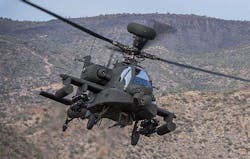Army orders 35 AH-64E Apache Guardian attack helicopters in $591.2 million contract to Boeing
Officials of the Boeing Defense, Space & Security segment in Mesa, Ariz., will build 35 new AH-64E Apache Guardian attack helicopters with advanced avionics under terms of the contract modification, awarded by the Army Contracting Command at Redstone Arsenal, Ala.
The deal is the second big Army helicopter contract in as many weeks. On 12 Feb. the Army awarded a $220.6 million contract to Airbus Helicopters Inc. in Herndon Va., to build 41 UH-72A Lakota utility helicopters equipped with the Raytheon AN/ARC-231 Airborne Communication System.
Last April Boeing won a $103.8 million contract for long-lead items in preparation for Thursday's AH-64E production order. Long-lead-item contracts enable defense contractors to buy difficult-to-obtain items well in advance so they can meet contract schedules.
Last month Boeing won a $14.6 million long-lead-item contract modification related to Thursday's production order. The original contract and its two modifications involve for full-rate-production of Lot 5 AH-64E helicopters.
The AH-64 Apache is a multirole combat helicopter with integrated avionics and weapons, as well as advanced digital communications to enable real-time, secure transfer of battlefield information to air and ground forces.
The E-model Apache Guardian features enhanced performance, joint digital operability, improved survivability and cognitive decision aiding, and reduced operating and support costs, Boeing officials say. The AH-64E Apache is being delivered to the U.S. Army and has been selected by several international defense forces.
Formerly known as AH-64D Block III, the AH-64E Guardian has improved digital connectivity, the joint tactical radio system (JTRS), more powerful T700-GE-701D engines with upgraded transmission to accommodate more power, capability to control unmanned aerial vehicles (UAVs), new composite rotor blades, instrument flight rules (IFR) capability, and improved landing gear.
The AH-64E will have self-diagnostic abilities, Link-16 data linking, and updated Longbow radar with oversea capacity that could enable naval strikes.
story continues below
Versions of the AH-64 Apache attack helicopter have been in service with the U.S. Army since 1986. It is a four-blade, twin-engine attack helicopter with a tandem cockpit for a two-man crew.
It has a nose-mounted sensor suite for target acquisition and night vision systems. It is armed with a 30-millimeter M230 Chain Gun carried between the main landing gear, under the aircraft's forward fuselage.
The helicopter has four hardpoints mounted on stub-wing pylons, typically carrying a mixture of AGM-114 Hellfire missiles and rockets. The helicopter was designed to replace the Bell AH-1 Cobra as the Army's primary attack helicopter. The U.S. Marine Corps still operates late-model versions of the AH-1 Cobra.
On this week's contract modification, Boeing will do the work in Mesa, Ariz., and should be finished by this July. For more information contact Boeing Defense, Space & Security online at www.boeing.com/boeing/bds, or the Army Contracting Command at Redstone Arsenal at www.acc.army.mil/contractingcenters/acc-rsa.
